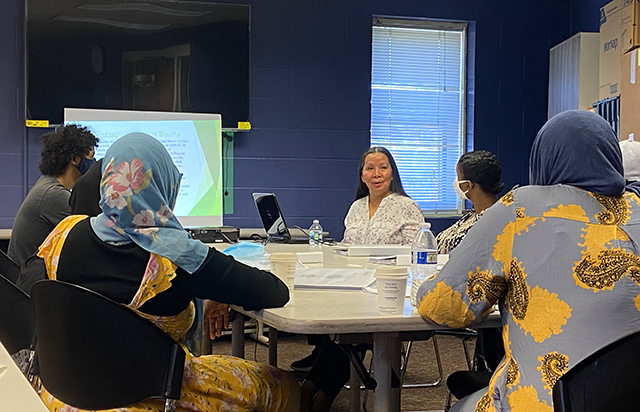Mohamed Abdi, 21, would take his younger siblings to their local community center in the Cedar-Riverside neighborhood to play basketball like he used to as a kid. But with more instances of crime in the area, he would worry about their safety.
He started attending neighborhood safety meetings, where he learned the city of Minneapolis awarded the neighborhood a grant as part of a pilot program aimed at improving safety in communities. So he signed up, and in his new role he hopes to assist his neighbors while keeping his siblings and other kids safe.
“It’ll help me put myself in a better position with the community overall just by walking around and interacting with people who need help,” Abdi said. “People can trust me because I am from this community.”
City officials and neighborhoods alike hope the program – another in a variety of public safety alternatives and violence prevention efforts – will help to deter crime in parts of the city.
The pilot program
The Minneapolis Community Safety Specialist pilot program is an effort to improve safety citywide while providing training and internship opportunities in fields such as law enforcement, criminal justice and violence prevention, according to a city document requesting proposals for the funding. The $1 million grant program is funded by federal American Rescue Plan dollars received by the city during the pandemic, and was made available to underserved neighborhoods that need more help in reducing crime and preventing violence.
The Cedar-Riverside neighborhood was one of the neighborhoods. The Cedar Riverside Community Council (CRCC), in partnership with the area’s West Bank Business Association and local nonprofits, submitted a proposal featuring an ambassador program that would place individuals around the neighborhood to act as violence interrupters. The city awarded the neighborhood $400,000.
The first group of prospective ambassadors, all residents of the neighborhood, began undergoing crisis intervention training earlier this month that involved acted-out scenarios, an academic portion on what mental health crises look like and testimonials from individuals in their interactions with police while they were in crisis.
What followed was more training in things like how to do outreach on the street and how to administer NarCan to someone experiencing an opioid overdose, and an online security training that ends with certification.

Abdi, who was born and raised in the neighborhood, said having people from within the community in the program quickly builds rapport between ambassadors and residents. Community members are more likely to interact and ask for help if they have seen you around the tight-knit neighborhood or know you speak their language.
“They know your family members or they know your grandparents,” he said. “That’s a much longer lasting and effective connection than bringing someone who is not from this community.”
City’s other efforts
The program joins the city’s other violence prevention efforts, which include youth workers engaging other young people in their neighborhoods, a juvenile supervision center that helps kids who have run-ins with police and a program that assists victims of violence.
Another one of those efforts is the MinneapolUS Strategic Outreach program, which uses the Cure Violence approach – an approach developed more than 20 years ago that treats violence as a public health problem.
A group of seven nonprofits contracted with the city to place teams of individuals wearing brightly colored shirts around the city in high-crime areas like the Lake Street corridor in south Minneapolis and West Broadway Avenue on the city’s Northside. The unarmed “violence interrupters,” 151 individuals trained in conflict resolution, attempt to identify situations that could potentially become violent and de-escalate before that happens, while also connecting victims of violence with help and services.
Earlier this summer, the office presented the interrupter program’s progress to a city council committee, finding that the interrupters had made more than 8,900 contacts with people on the street from mid-May 2021 through the end of the year.
“We recognize that when something happens, law enforcement needs to step in,” Sasha Cotton, the Office of Violence Prevention’s former director, told council members. “Our goal is to do that work before the bad thing happens, to de-escalate that conflict before the bad thing happens.”
More than 3,900 of those contacts resulted in interrupters providing services or resources to someone in need, or directing them to where to get them, according to the presentation.
Interrupters also successfully de-escalated more than 1,500 conflicts and situations that could have led to violence, according to program officials.
“We had a young man … he was getting ready to shoot. He had two guns – not one, two. And he was getting ready to shoot another young man over a dispute,” said Connie Rhodes of Restoration Inc., describing one encounter to council members. “Our violence interrupters stepped in right there. They could’ve run because he was ready to pop, but they talked him down. They were able to de-escalate him.”
Awed said CRCC hopes to have the group of ambassadors stationed at four different areas around Cedar-Riverside next week.
Over the next 12 months, the group will also do other things like act as “way-finders” for people who need help with where to find services or specific locations, staff a hotline, and engage in litter pickup and graffiti removal, among a wide variety of other tasks.
As the youth workers aim to have an impact on the safety of the area’s residents, Awed said he hopes the program will make an impact on the youth workers’ lives after the program ends.
“Not only is the goal of (the pilot program) ultimately for our kids here to make an impact in the neighborhood and the livability and safety conditions of the neighborhood,” Awed said. “But more importantly, getting them to gain the skills, confidence, and experience to go ahead and accomplish the goals they have set out for themselves for the future.”

0 Commentaires